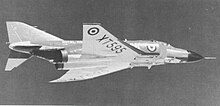
The United Kingdom (UK) operated the McDonnell Douglas F-4 Phantom II as one of its principal combat aircraft from 1968 to 1992. The UK was the first export customer for the F-4 Phantom, which was ordered in the context of political and economic difficulties around British designs for the roles that it eventually undertook. The Phantom was procured to serve in both the Royal Navy's Fleet Air Arm (FAA) and the Royal Air Force (RAF) in several roles including air defence, close air support, low-level attack and tactical reconnaissance.
The bulk of the UK's Phantoms were a special batch assembled in the United States, but with a significant amount of British technology as a means of easing the pressure on the domestic aerospace industry in the wake of major project cancellations.[1] Two variants were initially built for the UK: the F-4K variant was designed from the outset as an air defence interceptor to be operated by the FAA from the Royal Navy's aircraft carriers, and the F-4M version was procured for the RAF to serve in the tactical strike and reconnaissance roles. In the mid-1980s, a third Phantom variant was obtained when fifteen second-hand F-4J aircraft were purchased to augment the UK's air defences following the Falklands War.
The Phantom entered service with both the FAA and the RAF in 1969. In FAA service, while primarily intended for fleet air defence, it had a secondary conventional and nuclear strike role, while in the RAF it was soon replaced in its initial tasks by other aircraft designed specifically for strike, close air support and reconnaissance, and instead was moved to the air defence mission. By the mid-1970s, the Phantom had become the UK's principal interceptor, a role in which it continued until the early 1990s.
- ^ Davies 2016, p.25
